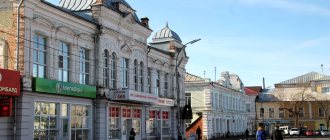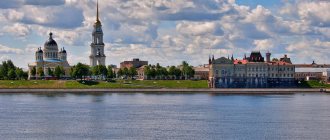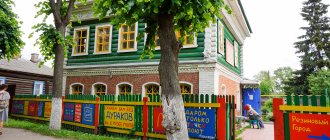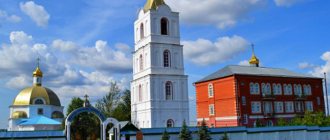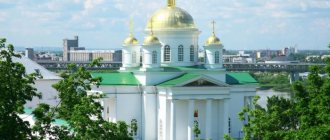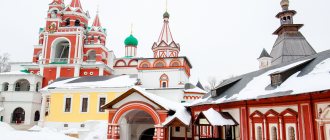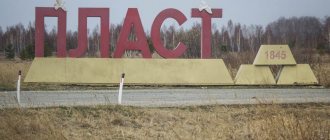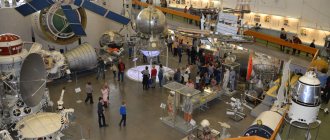Zvenigorod is one of the ancient cities of Russia.
It is located in the Moscow region, on the banks of the Moscow River. It is easy to get from Moscow to Zvenigorod, the drive is only 30 km. The city got its name from the word “Ring” or “Ringing”, from the chimes of bells that were heard here on holidays and weekdays and were heard far beyond its borders. It is a popular cultural and resort city in Central Russia. There are many ancient monuments because the city has a rich history. If you would like to take a look at the city, you are welcome. You will see the beautiful sights of Zvenigorod and get acquainted with the history of the city. Today we will advise you what to see in Zvenigorod. 10 best hotels in Zvenigorod (from RUB 2,028) on Booking =>>
Savvino-Storozhevsky Monastery
Monument to Savva Storozhevsky
Website: www.savvastor.ru Address: Ratekhinskoye sh., 8.
The Savvino-Storozhevsky Monastery was founded in 1398 on the banks of the Moskva River at the request of Prince Yuri of Zvenigorod, the second son of Prince Dmitry Donskoy. To create a monastery, he invited a disciple of Sergius of Radonezh, the Monk Savva.
Cathedral of the Nativity
The basis of the monastery was the wooden Nativity Cathedral built on Mount Storozh. In 1404-1405, a white stone temple was erected in its place, which belongs to early Moscow architecture. The Monk Savva was buried in the Nativity Cathedral.
The bell tower is the tallest building on the territory of the monastery.
Over its long life, the monastery took part in many historical events and saw many great princes, kings and emperors within its walls. During the time of Tsar Alexei Mikhailovich, the royal palace and royal chambers were built here. The Savvino-Storozhevsky Monastery became a country residence for the royal family in the 17th century.
Royal Palace
During the Patriotic War of 1812, the monastery was occupied by the French and suffered. It was closed in 1918, here on May 15 of the same year the Zvenigorod rebellion took place and three people representing the Bolshevik government were killed. In 1919, the shrine containing the relics of Savva Storozhevsky was publicly opened as part of anti-religious propaganda.
The monastery reopened in 1995. A new shrine was created to store the relics, which is now located in the monastery.
Excursions
In order to get to know the sights of Zvenigorod better, you can take advantage of thematic excursion walks:
- Ancient Kremlin on Gorodok . Duration – 1 hour, cost 2100 rubles. from 1 to 15 people. A fascinating excursion will tell and visually present the history of the emergence of Zvenigorod, starting with the founding of the outpost by Yuri Dolgoruky.
- A walk through the county town . Duration 2.5 hours, cost 5250 rubles. from 1 to 20 people. A walk through the streets of Zvenigorod will present a complete picture of the life and everyday life of local residents throughout the history of the city.
- Skete of St. Savva of Storozhevsky . Duration 1 hour, cost 2100 rub. from 1 to 15 people. The excursion route runs through the holy and ascetic places of the Zvenigorod Wonderworker St. Savva. The guide will tell you the history of the monastery and the life of St. Savva.
Zvenigorod Museum
Royal Chambers
Website : zvenmuseum.ru Address: on the territory of the Savvino-Storozhevsky Monastery. Opening hours: from 10.00 to 18.00 (ticket office until 17.00) daily, except Monday. In summer: Tuesday - Friday, Sunday from 10.00 to 18.00 (ticket office until 17.30), Saturday from 10.00 to 19.00 (ticket office until 18.30). Cost of a full ticket (2 expositions + 2 exhibitions): 280 rubles, pensioners - 200 rubles, schoolchildren and students - 160 rubles, preschoolers - free.
The museum in Zvenigorod was created in 1920, its history was not easy. At first the museum was located in the Vvedenskoye estate; in 1923 it moved to the closed Savvino-Storozhevsky Monastery. The main museum funds were valuables from the monastery sacristy and items from surrounding estates.
In 1927, a commune for street children was opened in the monastery and the museum was closed, but was reopened in 1928. In 1939, the museum was closed again due to the location of a military unit in the monastery. The main exhibits were transferred to the museum of the city of Istra, the rest were taken to the Assumption Cathedral in Zvenigorod - it was there that the museum was reopened in 1944.
In 1946, the Assumption Cathedral was handed over to believers and the museum was again moved to the territory of the former monastery, where the sanatorium was located. In 1987, the museum became the owner of the entire territory of the monastery, but already in 1995 the Russian Orthodox Church resumed its work here. Currently, museum workers are located in a single building - in the Royal Chambers. All other buildings were transferred to the Russian Orthodox Church.
The full name of the museum is Zvenigorod Historical, Architectural and Art Museum. In 1972, the works of the People's Artist of the RSFSR, artist B. N. Yakovlev, were transferred to the museum, which served as the beginning of a collection of paintings.
Assumption Cathedral in Gorodok
The Savvino-Storozhevsky Monastery also owns the Cathedral of the Assumption of the Blessed Virgin Mary, located outside its territory, which is its courtyard. It is located within the former fortress called Gorodok - the oldest part of Zvenigorod. The Assumption Cathedral, like the stone Nativity Church, was erected by order of the Zvenigorod Prince Yuri Dmitrievich at the turn of the 14th–15th centuries. Only part of the earthen ditches has been preserved from the Gorodok fortress.
The architecture of the cathedral is made in the traditions of Moscow white stone architecture. The Assumption Cathedral, like the Church of the Nativity, is one of four churches that have survived from the time of the Moscow Principality (the other two are located in Moscow). Both Zvenigorod churches have a rare feature - sloping walls. It is assumed that the purpose of this difficult-to-implement construction technique was the desire to visually make the churches taller.
Assumption Cathedral in Gorodok
The interior of the cathedral is of particular value. In 1918, already in Soviet times, during restoration, three icons were discovered, presumably by Andrei Rublev himself. They were moved to the Tretyakov Gallery, where they are still kept. The frescoes, created by icon painters of the Rublev school, have survived in fragments; the rest of the painting dates from the 19th century.
Inside the Assumption Cathedral
The cathedral generally survived the Soviet era successfully. It was, however, closed in 1930, but it resumed work in 1946. Two years before that, the Zvenigorod Museum operated in its premises.
At the end of the 19th century. The wooden Church of the Epiphany was built next to the Assumption Cathedral. The goal was to unload the cathedral with valuable frescoes, possibly by Rublev himself. In the 30s, the church was burned, and at the beginning of the 21st century. in its place a brick church was built with elegant kokoshniks on the facade.
View of the cathedral facades
The Assumption Cathedral, like the Savvino-Storozhevsky Monastery, is also located in a picturesque area with an evergreen pine forest.
Address: st. Gorodok, 1. Opening hours: Monday-Friday - 10-14, Saturday-Sunday - 10-19.
Monk Sava's monastery
The story goes that Savva Storozhevsky (Zvenigorodsky) made a refuge in a cave, where he spent the remaining days of his life, devoting them to prayers. Later, in the 19th century, a monastery was erected on this site.
During the Soviet era, the monastery was seriously damaged; buildings on its territory were destroyed or looted. In the 2000s, the buildings began to be restored: two churches were rebuilt and a monastery bathhouse was erected. The most beautiful building of the monastery is the Church of Sava, decorated with white stone decoration in the pseudo-Russian style.
Moskovskaya street:
The center of Zvenigorod is defined by two main parallel streets, closed in a one-way traffic ring: Moskovskaya and Vasily Fabrichny (which turns into Ukrainian). The length of these streets is no more than two blocks, on which 1/3 of all the attractions of Zvenigorod are concentrated.
Due to the large congestion of cars, it is difficult to photograph historical houses.
And here it is not clear: either a new building, or a well-restored house.
Unexpectedly, in the dining room they bought Vyatka kvass, which had been advertised throughout the country. Not bad, but nothing more.
Geese and a snowman ride in a semi-barrel on wheels, harnessed by small reindeer. You can't just pass by.
Memorial to the Eternal Flame
Monument to the fallen Zvenigorod residents and soldiers of the Fifth Army of the Western Front and the eternal flame . In 1941, Zvenigorod defended the western part of the country and the approaches to Moscow: anti-tank ditches were dug, anti-personnel barriers were installed, and a fighter battalion was formed. When the Germans approached Zvenigorod at a critical distance and were practically celebrating victory, the Zvenigorod residents were able to stop the enemy at the northern gates of the city.
Monument to the fallen Zvenigorod residents and soldiers of the Fifth Army of the Western Front and the eternal flame
Monument to A.P. Chekhov
Across the road there is a wonderful monument to A.P. Chekhov - an exact copy of a photograph of Chekhov in Melikhovo with his dachshund Khina from 1897.
Cultural Center named after. L. P. Orlova
Lyubov Petrovna Orlova (1902 - 1975) is a domestic film star of Hollywood proportions. She played on the stage of the theater and starred in films: “Jolly Fellows”, “Circus”, “Volga, Volga”, “Spring”, etc. Orlova for many years was the prima donna of the Soviet film screen, distinguished by her exquisite aristocratic appearance and well-groomed appearance. This talented woman was born and raised in Zvenigorod, it is not surprising that an entire cultural complex was built in her honor.
Cultural Center named after. L. P. Orlova
Monument to L.P. Orlova
Purchase yard
An interesting modern place in Zvenigorod is Kupchiy Dvor . This is a row of houses in the spirit of the 19th century, which sell various designer items, fashionable clothes in the Russian style, and host master classes. In general, you can come here just like visiting a museum and have a pleasant time!
Merchant's yard. Zvenigorod
Merchant's yard. Zvenigorod
Merchant's yard. Zvenigorod
Alexander Nevsky Church
The church was built in 1902 by decision of the Zvenigorod assembly in honor of Emperor Alexander III. In 1938, the temple closed, but its fate was not as sad as that of the Ascension Church: the building was rebuilt to meet the needs of other institutions, but was not destroyed. After the return of the church building in 1991, several stages of restoration and restoration work were carried out to return to its original appearance.
Church of Alexander Nevsky. Zvenigorod
Church of Alexander Nevsky. Zvenigorod
Church of Alexander Nevsky. Zvenigorod
It was strange to see a children's playground in the churchyard. This is probably due to the fact that there is a children's Sunday school and library on the church premises.
Church of Alexander Nevsky. Zvenigorod
Monument to Prince Yuri Zvenigorodsky and Savva Storozhevsky
The final attraction on Moskovskaya Street for us was the monument to the Russian prince Yuri Dmitrievich Zvenigorodsky and Savva Storozhevsky , about whom much has already been written. The monument was erected in 2005 on the 853rd day of the city.
Monument to Prince Yuri Zvenigorodsky and Savva Storozhevsky
So we walked from end to beginning all of Zvenigorod. It was a good walk and not at all tiring. Construction is in full swing next to the monument and the church; Zvenigorod is being built up with Moscow High-Rise buildings, and very chaotically and unceremoniously on historical sites.
Zvenigorod town
Assumption Cathedral on Gorodok
Gorodok in Zvenigorod is the remains of the Kremlin and the center of the ancient city. Now there is almost nothing left on the site of the fortress, once reliably protected by towers and earthen embankments. The most significant building is the Assumption Cathedral on Gorodok - the oldest temple in the city (late 14th - early 15th centuries), it is very reminiscent of the famous Church of the Intercession on the Nerl.
Most tourists, when visiting the sights of Zvenigorod, begin with the Assumption Church. The 15th century paintings of Andrei Rublev and Danila Cherny have been preserved here.
Rest
In Zvenigorod you can relax not only by visiting historical monuments, but also by choosing a more modern way:
- Leisure. Fans of active recreation in Zvenigorod will find entertainment to their liking at any time of the year. In winter, the city and its suburbs have excellent ski slopes of various difficulty levels. Sports fishing competitions are held on the Dubeshnya River. You can also try yourself as a horse rider, taking exciting horseback rides around the city and surrounding area. In the summer, you can kayak down the Moscow River or take a helicopter tour, viewing the sights of Zvenigorod from a bird's eye view.
- Interesting places to relax with children. When visiting Zvenigorod with children in the summer, it is impossible to resist the temptation and refuse to look into the “Miracle Park”, located not far from the city. The entertainment provided by the park will appeal to children and adults of all ages. More than 50 attractions, gazebos, equipped places for fishing, themed playgrounds, a cafeteria, a cable car, sports grounds - this is a short list of what “Miracle Park” has to offer. This is a wonderful place for a family and friends holiday. The park begins welcoming guests in May, all days except Monday and Tuesday.
Ascension Church
Address: Moskovskaya st., 2A.
In 1791, a stone Ascension Church was erected on this site on the site of an ancient wooden one. Before the Soviet period, this was the main temple in the city. In 1922, the church was closed for services and was used as a grain warehouse, and then as a garage. Before the start of the Great Patriotic War it was dismantled.
For many years, the site of the temple was a wasteland; the Church of the Ascension was rebuilt in 2007. The new building was built in the neo-Byzantine style and does not in any way resemble the historical building.
Red Mountain Street
After visiting Chekhov's places, we go to the center of Zvenigorod. On the way up, Red Mountain Street is filled with private houses. I am glad that some modern houses fit well into the ancient Russian buildings. For example, the houses opposite Chekhov's house.
There are some(!) houses that are well looked after and maintained in appearance. Nice houses, but the fence ruins everything. I don’t even know which of these fences is worse.
Literally five meters later, a low-rise residential complex rises in front of us.
On the other side of the road is just some kind of golden palace of an Indian Raja.
I wonder if it’s normal for residents of a golden new building to see this from their window every day?
Or that?
Or this? By the way, in this terrible house from 1922 to 1941. the Zvenigorod planetary school was located , and then the flying club , whose cadets became pilots during the Great Patriotic War. Zvenigorod, aren't you ashamed?
Chekhov in Zvenigorod
In 1884, A.P. Chekhov worked for some time as the head of the Zvenigorod City Hospital. Working here gave him many creative ideas for his works. In memory of the great writer, memorial plaques were installed: at the hospital where he worked, at the house where he lived and near the linden tree under which he loved to sit. The linden tree has not survived to this day; all that remains of it is a historical stump.
In Zvenigorod there is Chekhov Street and a monument on Moskovskaya Street.
Route for exploring the city on your own in 1-2 days
To explore Zvenigorod on your own, you can use the provided route:
- You should start your walk around Zvenigorod with a visit to the Cathedral of the Assumption of the Mother of God. Near the foot of the hill on which the temple is located there is a holy spring.
- The next point will be the Cathedral of the Ascension, located on Moskovskaya Street.
- Next to the Cathedral of the Ascension of the Lord there is a monument to Anton Pavlovich Chekhov with a dog.
- The next place to visit will be the Lyubov Orlova Museum, also located on Moskovskaya Street.
- Next is the Museum of Russian Dessert, which is worth a visit while in Zvenigorod.
- Continuing along Moskovskaya Street, you should visit the Church of Alexander Nevsky.
- You can complete your tour of the city with a monument dedicated to the founders of the city - Yuri Dmitrievich and Savva Storozhevsky.
Museum of Russian Dessert
Website: rusdessertmuseum.ru Address: st. Frunze, 23/2.
The museum, opened in 2013, is dedicated to the culture of Russian tea drinking, ancient recipes for sweets that are still popular today: candy, gingerbread, and jam. You can visit the place for free, but you will have to pay for the tasting.
The museum contains ancient cupboards from all over Russia, which now contain herbs that replaced tea for peasants. Here you can not only study sweets, but also take part in master classes on how to make them.
House and linden tree of A.P. Chekhov
Coming out of Gorodok onto Krasnaya Gora Street, we immediately come across the former house of Anton Pavlovich Chekhov . I think everyone is familiar with his stories, which are interesting to read at any age, but not everyone knows that Anton Pavlovich worked as a doctor in Zvenigorod. This happened in 1884, when the local doctor Uspensky was forced to take a vacation for a month, and in return he asked Anton Pavlovich to work for himself. At that time, Chekhov graduated from Moscow University and was just beginning his writing career. This is what he wrote to a friend about his life in Zvenigorod:
● from a letter to N.A. Leikin dated June 25, 1884: “...They offered me a position as a zemstvo doctor in Zvenigorod - I refused...”
● from a letter to N.A. Leikin dated July 14, 1884: “Currently I am in the city of Zvenigorod, where, by the will of fate, I am filling the position of a zemstvo doctor, who asked me to replace him for 2 weeks. Half the day I am busy receiving patients (30–40 people a day), the rest of the time I relax or am terribly bored, sitting by the window and looking at the dark sky, which has been pouring for the 3rd day now, bad, non-stop rain... In front of my window there is a mountain with pine trees, to the right the house of the police officer, even to the right a lousy little town that was once a capital city... To the left is an abandoned rampart, to the left is a small forest, and from behind the latter the consecrated Savva peeks out. The back porch, or rather the back door, near which it smells like a toilet and a pig grunts, looks out onto the river.”
● from a letter to N.A. Leikin dated mid-July 1884: “...Or do this: go to the second station of the Smolensk road, Golitsyn. From here to Zvenigorod (15 versts) on horseback. In Zvenigorod we will see the consecrated Savva and drive from here to New Jerusalem (20 versts). All this will take you no more than a day. Grab Palmin. I warn you in advance: you will not find any amenities along the way... The roads and cities are worse than the worst, but there is a lot of fictional material. If you spend the night with me, I’ll take you to the hospital for an appointment (story in 300 lines). On Elijah, the 20th, I will have 60 sick people, on the 22nd 40 people. You will do better if you start your journey in Zvenigorod. The roads are bumpy, but picturesque..."
Chekhov's house in Zvenigorod
Chekhov's house in Zvenigorod
Rounding the house of A.P. Chekhov, we came across two brand new multi-colored buildings still under construction. First thought: “Probably a museum!” But no, it’s not at all clear what kind of buildings these are, for what purpose they were built and why one of them wants to push Chekhov’s house into a ravine?
Across Krasnaya Gora Street, on Oktyabrskaya Street, we found a stump with a memorial plaque. This is a former linden tree under which Anton Pavlovich loved to relax with his new acquaintance, the paramedic, Sergei Vasilyevich Barmintsev. The Chekhov linden tree a stump in 2013, when the old tree was first damaged by strong winds, and then completely broke due to snowfall.
Lipa Chekhova
Nearby, the house of the Barmintsev family has been preserved (one-story with carved platbands), where the descendants of paramedic Sergei Vasilyevich continue to live.
House of paramedic Barmintsev
Museum Back to the USSR
Website:
www.ussrmuseum.ru
Address:
Moskovskaya st., 7/9.
Opening hours: from 10.00-20.00, seven days a week. Tour cost: 350 rubles, children - 250 rubles, under 5 years old - free.
A place for those who not only want to explore the sights of Zvenigorod in detail, but also immerse themselves in memories - the Back to the USSR Museum. Here are presented interior items and equipment from the 50s to the 80s of the 20th century: televisions, gramophones, clothes, toys. Some of the exhibits can be touched. Excursions are conducted separately for adults and for those who no longer lived in the Soviet Union.
The museum staff is more focused on young visitors. Master classes are held here for children, where schoolchildren learn to burn wood and create handicrafts with their own hands. Those interested can view the filmstrips. A local cafe sells milkshakes and cakes prepared according to Soviet recipes.
Cultural sites of Zvenigorod
Zvenigorod is interesting not only for its churches and monasteries.
Cultural Center of Lyubov Orlova
Soviet film actress No. 1 is a native of Zvenigorod, where she spent her childhood years. In 2007, on the 105th anniversary of her birth, the Orlova Cultural Center was opened in the city.
Entrance to the cultural center of Lyubov Orlova
It includes a concert hall, exhibition spaces and a small memorial museum for the film actress. In 2021, the only monument in the country to the People's Artist of the USSR and two-time winner of the Stalin Prize was unveiled in front of the center. The original monument to Lyubov Orlova is truly national: it was erected with funds from citizens and organizations.
Monument to Lyubov Orlova
The Center regularly organizes meetings with many famous actors and musicians who have visited here, educational concerts of classical music for children and adults, opening days, humor evenings, and other cultural events. The Center hosts an annual summer theater school for young Russian actors, with classes taught by leading artists.
Orlova Cultural Center at st. Moskovskaya, 11, can be visited on Tuesday – Saturday from 10 to 18 hours. A regular ticket costs 100 rubles, and for an hour-long excursion in a group of 5–25 people - 150. You should sign up for the excursion in advance by calling 8 (495) 642-07-50.
Museum "Back to the USSR"
You can continue your immersion in the Soviet past on the same street. The “Back to the USSR” museum is a reflection of nostalgia for Soviet times, characteristic of a significant part of Russian society, especially those who managed to live in them. The museum's exposition represents Soviet life - decoration, appliances, objects, books, toys, clothes.
Museum exposition “Back to the USSR”
The half-hour excursion “Back to the USSR” is designed for adult visitors. An apartment building in a typical Soviet room is accompanied by Soviet-era music playing from a gramophone or radio. “Half an hour without gadgets” is the name of an excursion for modern schoolchildren with viewing filmstrips through a slide projector. There are also master classes for them with training in wood burning, paper crafts, and gingerbread painting.
The museum buffet offers adults and children ice cream, lemonade, dumplings and cakes that claim to be made according to Soviet GOST standards, which excluded the use of preservatives and non-natural ingredients. And the souvenir shop sells “Red Moscow” perfume and “Chypre” cologne.
Address: st. Moskovskaya, 18. “Return to the USSR” is possible daily from 10 to 20 hours. The cost of the excursion for adults and schoolchildren is 300 and 250 rubles. respectively. A separate fee is charged for apartment housing - 1000 rubles, viewing filmstrips - 100 rubles, and master classes - 200-450 rubles.
Prishvin House-Museum
Mikhail Prishvin was called the singer of Russian nature. He was an unsurpassed master of her colorful descriptions. The natural beauty of Zvenigorod and its surroundings did not pass the writer’s attention. In 1946, he purchased a dacha in the village of Dunino not far from the city. The area reminded Prishvin of his native Lipetsk region, but the dacha clearly did not resemble local suburban buildings. This shouldn’t be surprising: after all, the first owner of the dacha was Finnish Maria Oswald, who built it at the turn of the 19th and 20th years.
Prishvin House-Museum
The house is surrounded by an apple grove and a linden alley. For about a decade, Prishvin and his wife lived in the country from May to October. Here he was visited by friends, among whom were famous people - conductor Mravinsky, physicist Kapitsa, writer Fedin. After Prishvin’s death in 1954, Valeria Dmitrievna achieved the creation of a museum at the dacha, where she herself worked as a caretaker and guide. The exhibition includes an office, a library, a veranda and a dining room, furnished with antique furniture and household items of the first half of the 20th century.
The Prishvin House Museum is open Wednesday – Sunday from 10 a.m. to 4 p.m. A regular ticket costs 250 rubles, and an excursion ticket costs 350. A city bus runs from Zvenigorod to the Museum, passing through Nikolina Mountain.
Zakharovo Estate
This estate is part of the structure of the Odintsovo State Museum-Reserve of A. S. Pushkin. The fact is that the estate belonged to the grandmother of the poet M.A. Hannibal. In early childhood, he was brought to his grandmother’s estate every summer. Its original building was lost, and the current building was recreated for the 200th anniversary of the birth of Alexander Sergeevich.
Zakharovo Estate
The estate is surrounded by an old park with a pond and trees - linden and birch trees, some of which “remember” the young poet. A ticket to Zakharovo costs 250 rubles. On Pushkin Memorial Day - February 10, admission is free. The cost of the excursion for groups of up to 20 people is 1960 rubles.
Big Vyazemy Estate
The aforementioned Odintsovo Pushkin Museum was created in 1987 on the basis of the palace and park ensemble of the Vyazema estate near Zvenigorod. This area was a royal possession, it belonged to Boris Godunov, then to the princes Golitsyn. The main building of the ensemble, a stone mansion that has survived to this day, was erected by them in the 18th century. At the same time, another surviving structure was built - the Transfiguration Cathedral.
The palace was visited by many famous people, including Pushkin. Some researchers believe that the owner of the palace, Natalya Petrovna Golitsyna, served as the poet’s prototype for the character in “The Queen of Spades,” and the Golitsyn estate is described in “Eugene Onegin.” In Soviet times, successive shelters for homeless people, a military school, a parachute school, and institutes were based here.
The current museum complex consists of a palace with outbuildings, a horse yard, outbuildings, a park with a monument to Pushkin, ponds and the Transfiguration Cathedral. In the Golitsyn Palace there is an exhibition about noble life during the time of Pushkin.
Big Vyazemy Estate
The estate is open to visitors every day, except Mondays, from 10 to 17 (on Friday - until 16) hours. The conditions for excursions conducted not only in Vyazemy, but also in Zakharovo, can be found on the museum’s website.
Taneyev Museum in Dyutkovo
The famous Russian composer Sergei Taneyev spent the last years of his life and died in his village house in the village of Dyutkovo. Now there is a museum in it, in which the life of the composer is recreated. There is a monument to Taneyev in front of the hut.
Taneyev Museum in Dyutkovo
The Taneyev Museum can be viewed on Wednesdays, Fridays, Saturdays, and Sundays from 11 a.m. to 4 p.m. Classical music concerts are held there periodically.
The museum is located near the Savvino-Storozhevsky Monastery. From Zvenigorod you can get there by the same buses No. 23 and 51. You need to get off at the stop of the same name.
Museum of Russian Dessert
This museum brings together many types of Russian dessert. Here you can taste Tula gingerbread, Guryev porridge, Belyov pastila, bagels, and pies. They are prepared according to traditional recipes in a Russian oven or lamb bakery. Visitors can take part in thematic excursions:
- “Fat Meal” – about the traditions of receiving guests, the culture of tea drinking (with tasting of honey gingerbread!);
- “Sweet stories of old buffets” - about Ivan tea, cranberry sbitna with cinnamon and forgotten Russian desserts;
- “Lakomka” – tasting of mint tea with bagels prepared in a samovar;
- “Self-assembled tablecloth” is a folklore performance with stories and riddles on the theme of Russian desserts.
After the tour, you can purchase gingerbread cookies, marshmallows, honey, dandelion jam and other sweets displayed in the old buffet.
Museum of Russian Dessert
Address: st. Frunze, 23/2., opening hours: 10–20. Regular admission is free, but for one of the excursions with tea you need to pre-register by phone or Their cost for adults/children is 400/350 rubles. Those interested can participate in master classes:
- painting on gingerbread cookies and making sugar flowers for 400 rubles, lasting 40 minutes;
- baking bread for 2000 rubles. within 3 hours.
Monuments of Zvenigorod
In addition to the Orlova monument, there are two more memorable monuments in Zvenigorod. In 2005, opposite the Alexander Nevsky Church, a monument was erected to two personalities who played a major role in the history of the city. Prince Yuri Zvenigorodsky in military armor, having removed his helmet, respectfully listens to the instructions of the monk Sava, holding a book on his knees. The gaze of the founders of the Savvino-Storozhevsky Monastery is fixed on their distant descendants.
Monument to the founders of the Savvino-Storozhevsky Monastery
The outstanding Russian writer Anton Pavlovich Chekhov began his medical career in Zvenigorod. In 1884, after graduating from Moscow University, he replaced the zemstvo doctor Uspensky.
In 2010, on the 150th anniversary of the writer’s birth, the townspeople perpetuated the memory of this. The sculptor Kurochkin depicted the writer sitting on a city bench at the address: st. Moskovskaya, 12. In his right hand he holds a cane, and in his left hand he hugs a dog, information about which history has not preserved. Perhaps this is Kashtanka?
Monument to A.P. Chekhov
Cultural Center named after Lyubov Orlova
Address: Moskovskaya street, 11
It is no coincidence that the only museum in the world dedicated to the Soviet actress was opened in Zvenigorod - it was in this city that Lyubov Orlova was born. The interior of the building is designed in the style of a black and white movie; in front of the entrance to the museum there is a monument to the actress. Among the exhibits: Orlova's costumes, personal belongings, portraits, wind instruments used in films.
Tourists and local residents are especially keen to visit the cinema hall at the museum. Here you can watch films with the participation of the famous actress and documentaries covering in detail the biography of Lyubov Orlova. On certain days, the museum's cinema hall hosts performances by pop artists and children's shows.
City Park
It's surprising that such a small town as Zvenigorod has its own city park.
This place is hardly suitable for a full-fledged park. The park has two illuminated alleys with benches, a children's playground can be seen in the distance, the Foundation Stone of the Memorial to Internationalist Soldiers , and a bust of V. I. Lenin . It is interesting to look at this park in summer.
Zvenigorod city park
County Town Fashion Museum
Website: mmzven.ru Address: st. Ukrainskaya, house 6. Opening hours: Wednesday - Friday from 11.00 to 17.00, Saturday - Sunday from 11.00 to 18.00, Monday, Tuesday - closed.
The museum's exhibits demonstrate changes in fashion from pre-Petrine times to the era of the USSR. The museum is divided into separate halls, where samples of folk costume, dresses of fashionistas of the 19th century, and outfits of Soviet women are presented. The collections are supplemented with tools for needlework, toys, and jewelry.
You are allowed to touch all things with your hands, and some can be worked on. Museum staff conduct master classes where they teach how to use a loom and a spinning wheel. In the store located in the building, you can purchase art supplies and jewelry stylized from different eras.
What to bring as a souvenir
In Zvenigorod there is an unusual shopping complex, stylized as a Russian street from the mid-century. There are many shops on it where you can choose unusual hand-made gifts and souvenirs for any, even the most demanding taste.
Zvenigorod is a city filled with history; its attractions will leave an indelible mark on the soul after visiting.
I want to come back here and fill my heart with beauty and tranquility. The city with singing and ringing bells always welcomes guests.
Author of the article: Shishlina Anna
Article design: Svetlana Ovsyanikova
Zakharovo Estate
Website: www.museum-gol.ru Address: Moscow region, Odintsovo district, Zakharovo village.
In the 19th century, the grandmother of Alexander Sergeevich Pushkin bought the estate. The great poet spent his entire childhood on the estate. His stay at the estate and his grandmother’s stories inspired Pushkin to create the story “The Blackamoor of Peter the Great.” Later, all the buildings were destroyed and rebuilt only for the poet’s bicentenary.
Tourists can view the reconstruction of the estate. From Pushkin's times, only alleys and a pond have been preserved here. The estate is part of a museum-reserve; staff conduct excursions for adults and educational walks aimed specifically at children.
Travel tips
The sights and museums of Zvenigorod can be explored in one day. Even an inexperienced tourist can use a city map to find its memorable places. Parents with children are advised to plan a visit to Miracle Park separately from the excursion route around the city and its environs - the entertainment capabilities of the complex require considerable time.
A city map will help tourists find their way around Zvenigorod
Some tips for travelers:
- The Savvino-Storozhevsky Monastery is a functioning monastery. When visiting it, follow the internal rules, dress modestly, do not make noise or litter.
- Drink healing water from the holy spring of the Savvinsky monastery, swim in its bath and take a walk through the picturesque surroundings of the city. This heals and restores spiritual harmony.
- Independent tourists should sign up in advance for master classes at the Museum of Russian Dessert. This is especially important for parents with children.
- Buy small ringing bells in souvenir shops. This symbol of the city, depicted on the coat of arms of Zvenigorod, will help you preserve the impressions of your trip for a long time.
- For a more comfortable acquaintance with the sights of Zvenigorod, join a one-day bus trip using the services of Moscow travel agencies. You will not need to plan time to explore memorable places, buy entrance tickets to museums and worry about food.
Video: Zvenigorod from a bird's eye view
I've been to Zvenigorod twice. The first time was in 1982, while vacationing with my husband at the Svyazist boarding house, which was a 10-minute walk from the Savvino-Storozhevsky Monastery. Having independently examined its territory, we went into the museum and climbed the fortress wall. The place was almost deserted and very neglected. The surrounding area was enlivened by urban skiers who actively took advantage of the hilly terrain of “Switzerland near Moscow.” We had a great rest and regained our strength on ski trips after difficult college exams. I didn’t notice anything remarkable in the city itself - it seemed almost like a village to me. Last year’s trip to Zvenigorod greatly changed my opinion about it: the monastery and churches were restored, new museums were created. I was surprised by the beautifully planned development of one-story blocks of elite housing. The city has turned into a real Moscow region “pearl” and “paradise” for living, excursions and recreation. The streets have become well-groomed, clean and spacious. The surrounding area of the city has been enriched with resort opportunities. For example, on the territory of the old “Svyazist” they built a colorful complex “Taiga Dachas”, consisting of several cottages stylized as Russian huts. For independent tourists, there are many signs and plaques with historical information, which allows them to obtain information without the help of a guide. And in the museum-estate of M. M. Prishvin they can organize a tour of the house even for two visitors.
Prishvin House-Museum
Website: prishvin.ru Address: Odintsovo district, Dunino village, building 2. Opening hours: from 11.00 to 18.00 (ticket office until 17.30), closed on Monday. Cost: 200 rubles, students, pensioners - 150 rubles.
The writer bought a house in Dunino as a summer cottage in 1946. Mikhail Prishvin spent his summers here for the last 8 years of his life.
Apple and linden trees grow thickly around the house; the writer’s wife began growing them. And Prishvin himself said that walks in his garden inspire him to create new creations.
In the house you can see the writer’s hunting trophies, a collection of dishes and the decoration of the rooms. Prishvin’s personal car is still in the garage. The architecture of the building is unusual for the Moscow region; this is explained by the fact that the first owner of the estate came from Finland and a building was built for her, modeled on Finnish houses.
How to get there from Moscow?
Zvenigorod is a popular weekend route from Moscow. From there you can get to the city by bus or train.
Buses to Zvenigorod depart from several Moscow metro stations:
- “Kuntsevskaya” - No. 452 (from 7 to 22 hours);
- “Tushinskaya” - No. 455, reaching the Zvenigorod quarter “Ruza” (from 7 to 19 hours);
- “Strogino” – No. 881 – to the Mayakovsky quarter (from 6:30 to 22 hours).
The cost of travel on buses is approximately 150 rubles, and the travel time is 1 hour 15 minutes in the absence of traffic jams. The exact bus schedule is available on the website.
Electric trains to Zvenigorod regularly depart from the Belorussky and Savelovsky stations of the capital from 10 to almost 23 hours. The fare is about the same, and the travel time is 1 hour 40 minutes, which corresponds to the bus option with traffic jams. Every day at 18:06 the high-speed Express train departs from the Belorussky Station, spending only an hour on the journey. The ticket, of course, costs more - 180 rubles.
Lake Glubokoe
The reservoir, whose depth reaches 38 meters, is located in the forest near the city. Getting to the lake is quite difficult, but for tourists who dare to go on an excursion this is rather a plus: here you will not find crowds of vacationers and mountains of garbage.
Divers come to the lake and are not bothered by the cool water (maximum +6° even on hot days) and the springs that flow up to a height of 5 meters. The reservoir is also interesting for fishermen; perch, bream, pike, and eel are found here.
A little about the city
Zvenigorod, a suburb of Moscow, is located 70 kilometers from the center of the capital in a westerly direction. The area of the city is about 50 square kilometers, the population is 22.5 thousand people. The climate is moderate continental.
Historical features of the city
Archaeological research indicates the presence of a fortress on the territory of the city at the end of the 12th and beginning of the 13th centuries. The founding date of the city is considered to be 1152. But the first mention in the chronicle occurs in 1339, when the Zvenigorod appanage principality was formed, which existed until 1492. The city was ravaged several times by nomads, and in the Time of Troubles it was burned twice by pretenders to the Moscow throne.
Since 1708, the city became part of the Moscow province, and in 1871 it became the center of the county. But industry in Zvenigorod developed poorly - only small factories and handicrafts worked. This feature of the city has been preserved to this day - there are no large industries here, but a rich infrastructure for tourism and recreation has been created.
How to get to Zvenigorod
The city has a railway station and a bus station.
- From the capital's Savelovsky and Belorussky railway stations you can travel by train in 1 hour 45 minutes or by high-speed train in 1 hour to the Zvenigorod railway station, which is located 3.5 kilometers from the city center, which can be reached by public transport.
- The bus journey from Moscow takes 1 hour and 20 minutes. Buses depart from the Tushinskaya, Kuntsevskaya, Strogino metro stations and stop at any city stop.
- It is easily accessible by car via highways heading west.
You can get to Zvenigorod from Moscow by car along western federal highways
Equestrian farm Dyutkovo
Website: dutkovo.ru Address: Dyutkovo, 10
The courtyard has an interesting location: the equestrian club is located on the site of a bowl where a meteorite fell millions of years ago. There are no more than ten horses here each season. But the trails pass through places with an abundance of clean springs, where animals feel calm. Tourists often meet foxes, squirrels and birds along the road.
Participants in horseback riding are taught not only how to properly sit in the saddle. The program includes an introduction to the flora and fauna of the Moscow region and elements of orienteering.
Distinctive features of the city
Zvenigorod, whose sights were glorified back in the 12th century, is today a popular destination for vacationers. Forests, lakes and groves invite people to constantly return and relax their soul and body; thanks to these needs, the surroundings of Zvenigorod are equipped with a variety of resorts and boarding houses.
Features of Zvenigorod:
- Climate. Located in the central Russian zone, the city has moderate continental temperature conditions. In Zvenigorod, all 4 seasons of the year are clearly expressed, with a characteristic abundance of precipitation.
- Ecology. There are no hazardous industries or environmentally polluting enterprises on the territory of Zvenigorod and its environs. Highways and highways - Riga and Minskoe highways - are located at a distance from the city, separated by a forest belt, therefore, in environmental terms, Zvenigorod has the most advantageous position.
- Population. According to the latest census data, about 22 thousand people live in Zvenigorod. Mostly the population has Russian roots, but there are also representatives of more than 100 nations of the world, including citizens of both near and far abroad.
- Flora and fauna. In the forested areas surrounding Zvenigorod, as well as in protected reserves, there are more than 180 representatives of the flora and 80 species of animals and birds, some of which are listed in the Red Book.
Local news
Larisa Lazutina will hold a reception of citizens in Zvenigorod on December 6
On December 4, the III STREET MUSIC FESTIVAL will be held in Zvenigorod
Andrey Ivanov: Our task is to open a school in the Vostochny microdistrict by September 1, 2024
The first vending machines for collecting plastic and aluminum appeared in Zvenigorod
The Odintsovo city prosecutor's office approved an indictment in a criminal case against a resident of the Odintsovo city district
Seasonal vaccination of the population against influenza is underway in Zvenigorod
Zvenigorod may become part of the cities of the Greater Golden Ring
Six emergency facilities were liquidated in 11 months in Zvenigorod
The power grid complex of the Odintsovo urban district is ready for winter
A non-residential building in Zvenigorod was completely renovated
The prosecutor held a meeting of the working group on protecting the rights of participants in shared-equity housing construction
In November, mobile offices of Social Gasification will visit 8 settlements of the Odintsovo District
976 doctors from the Odintsovo district are taking part in the regional competition “People’s Doctor”
In 2021, Governor Andrei Vorobyov’s “My Entrance” program was resumed
The Zvenigorod deanery hosted the event “Let’s Warm Children’s Hearts”
The improvement of the City Park in Zvenigorod is 80% complete
A major overhaul of a unit of the Odintsovo regional hospital has been completed in Zvenigorod
The Ruza regional operator has extended the validity period of the “Farewell, fines!” promotion.
In 2022, as part of the governor’s program, 7 playgrounds will be installed in the Odintsovo district
For evaders from concluding a maintenance contract and gas defaulters
All local news
Cathedral of the Nativity of the Virgin.
The pearl and organizing center of the architectural ensemble is the Cathedral of the Nativity of the Virgin. It stands on the highest point of the hill. The Nativity Church is the most valuable monument of early Moscow architecture; it is one of the five most ancient stone churches of the Moscow princes
twa. There is no date of its construction in the chronicles, but researchers agree on the first decade of the 15th century. Despite the later additions that distorted the original forms of the temple, and the updated dome, dazzlingly shining with yellow gold, the Nativity Cathedral is beautiful in its true antiquity. Its white stone walls are decorated with fine carvings and frescoes from the 17th century, restored by autumn 2011.

